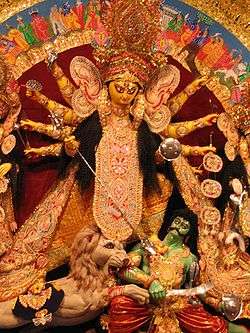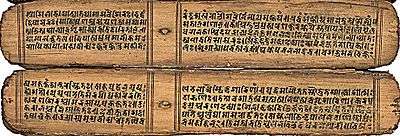Katyayani
Katyayani is one of the main forms of The Hindu Mother Goddess, Devi. She is seen as the slayer of the tyrannical demon Mahishasura. She is also the sixth form amongst Navadurga or the nine forms of Hindu goddess Durga (Parvati), worshipped during the Navratri celebrations.[1] She may be depicted with four, ten, or eighteen hands. This is the second name given for Goddess Adi Parashakti in Amarakosha, the Sanskrit lexicon (Goddess Parvati names- Uma Katyayani Gauri Kali Haimavati Ishwari). Goddess Katyayani was worshipped by Sita and Rukmini for a good husband.
| Katyayani | |
|---|---|
Goddess of Power | |
Daughter of Sage Katyayana, hence known as Katyayani | |
| Affiliation | Avatar of Parvati |
| Planet | Jupiter |
| Mantra | चंद्रहासोज्जवलकरा शार्दूलवरवाहना। कात्यायनी शुभं दध्यादेवी दानवघातिनि।। |
| Weapon | Khadga (longsword) Padma or Lotus, Abhayamudra, Varadamudra |
| Mount | Lion |
| Personal information | |
| Siblings | Vishnu |
| Consort | Shiva |
In Shaktism she is associated with the fierce forms of Shakti or Durga, a Warrior goddess, which also includes Bhadrakali and Chandika,[2] and traditionally she is associated with the colour red, as with Goddess Parvati, the primordial form of Shakti, a fact also mentioned in Patanjali's Mahabhashya on Pāṇini, written in 2nd century BCE.[3]
She is first mentioned in the Taittiriya Aranyaka part of the Yajurveda. Skanda Purana mentions her being created out of the spontaneous anger of Gods, which eventually led to slaying the demon, Mahishasura, mounted on the lion. This occasion is celebrated during the annual Durga Puja festival in most parts of India.[4]
Her exploits are described in the Devi-Bhagavata Purana and Devi Mahatmyam, part of the Markandeya Purana attributed to sage Markandeya Rishi, who wrote it in Sanskrit ca. 400-500 CE. Over a period of time, her presence was also felt in Buddhist and Jain texts and several Tantric text, especially the Kalika-Purana(10th century), which mentions Uddiyana or Odradesa (Odisha), as the seat of Goddess Katyayani and Lord Jagannath .[5]
In Hindu traditions like Yoga and Tantra, she is ascribed to the sixth Ajna Chakra or the Third eye chakra and her blessings are invoked by concentrating on this point.[1]
Origin Story

According to the Vamana Purana she was created from the combined energies of the gods when their anger at the demon Mahishasura manifested itself in the form of energy rays. The rays crystallized in the hermitage of Kātyāyana Rishi, who gave it proper form therefore she is also called Katyayani or "daughter of Katyayana".[6] Elsewhere in texts like Kalika Purana, it is mentioned that it was Rishi Kaytyayana who first worshipped her, hence she came to known as Katyayani. In either case, she is a demonstration or apparition of the Durga and is worshipped on the sixth day of Navratri festival.[7]

The Vamana Purana mentions the legend of her creation in great detail: "When the gods had sought Vishnu in their distress, he and at his command Shiva, Brahma and the other gods, emitted such flames from their eyes and countenances that a mountain of effulgence was formed, from which became manifest Katyayini, refulgent as a thousand suns, having three eyes, black hair and eighteen arms. Shiva gave her his trident, Vishnu a Sudarshan Chakra or discus, Varuna a shankha, a conch-shell, Agni a dart, Vayu a bow, Surya a quiver full of arrows, Indra a thunderbolt, Kuvera a mace, Brahma a rosary and water-pot, Kala a shield and sword, Visvakarma a battle-axe and other weapons. Thus armed and adored by the gods, Katyayani proceeded to the Mysore hills. There, the asuras saw her and captivated by her beauty they so described her to Mahishasura, their king, that he was anxious to obtain her. On asking for her hand, she told him she must be won in fight. He took on the form of Mahisha, the bull and fought; at length Durga dismounted from her lion, and sprang upon the back of Mahisha, who was in the form of a bull and with her tender feet smote him on the head with such a terrible force that he fell to the ground senseless. Then she cut off his head with her sword and henceforth was called Mahishasuramardini, the Slayer of Mahishasura.,[4] The legend also finds mention in Varaha Purana and the classical text of Shaktism, the Devi-Bhagavata Purana[8]
Other Legends
Raktabeej, an aide of Kolhasur, possessed a power (Siddhi) whereby every drop of his blood spilled on earth would give rise to a demon. Due to this power, Bhairava was finding it impossible to kill Raktabeej. Katyayani swallowed all of Raktabeej's blood without letting it fall on earth. She created an Amrut Kunda (tank of nectar) to rejuvenate Bhairava's soldiers, thus playing a crucial role in the war. Her temple to the South of Kolhapur commemorates this.[9][10]
The second among the 'Shaktipeeths' is Tulja Bhavani (Parvati) of Tuljapur. It is the family deity of the Bhosale Royal family, the Yadavs and of countless numbers of families belonging to different castes. The founder of the Maratha kingdom, Shivaji Maharaj always visited the temple to seek her blessings. It is believed that the Goddess DurgaBhavani(Katyayani) gave him a sword - 'the Bhawani sword' - for success in his expeditions. The history of the temple has been mentioned in the Skanda Purana.
According to Tantras, she revealed through the North face, which is one six Faces of Shiva. This face is blue in colour and with three eyes and also revealed the Devis, Dakshinakalika, Mahakali, Guhyakah, Smashanakalika, Bhadrakali, Ekajata, Ugratara (fierce Tara), Taritni, Chhinnamasta, Nilasarasvati(Blue Saraswati), Durga, Jayadurga, Navadurga, Vashuli, Dhumavati, Vishalakshi, Parvati, Bagalamukhi, Pratyangira, Matangi, Mahishasuramardini, their rites and Mantras.[11]
Worship
The Bhagavata Purana in 10th Canto, 22nd Chapter, describes the legend of Katyayani Vrata, where young marriageable daughters (gopis) of the cowherd men of Gokula in Braja, worshipped Goddess Katyayani and took a vrata, or vow, during the entire month of Margashirsha, the first month of the winter season, to get Lord Krishna as their husband. During the month, they ate only unspiced khichri and after bathing in the Yamuna at sunrise made an earthen deity of the goddess on the riverbank and worshipped the idol with aromatic substances like sandalwood pulp, lamps, fruits, betel nuts, newly grown leaves, fragrant garlands and incense. This precedes the episode where Krishna takes away their clothes while they are bathing in the Yamuna River.[12][13]
She is worshiped as the Adi shakti swaroop who if you make vow of fasting, would give you the husband you have wished and prayed for. The fasting, called Kātyāyanī-vrata is made for a whole month, offering such things as sandal, flowers, incense, etc.: "During the month of Mārgaśīrṣa, every day early in the morning the young daughters of the cowherds(gopis) would take one another's hands and singing of Krishna's transcendental qualities, go to the Yamuna(Jamuna) to bathe. Desiring to obtain Krishna as their husband, they would then worship the goddess Kātyāyanī with incense, flowers and other items".
Each day they rose at dawn. Calling out to others by name, they all held hands and loudly sang glories of Krishna while going to Kālindī(personified Jamuna) to take their bath.
The Adolescent Virgin Goddess in the southern tip of India, Devi Kanya Kumari is said to be the avatar of Devi Katyayani Or Devi Parvati. She is the goddess of penance and Sanyas. During the Pongal(Thai Pongal), a harvest festival, which coincides with the Makara Sankranthi and is celebrated in Tamil Nadu, young girls prayed for rain and prosperity and throughout the month, they avoided milk and milk products. Women used to bath early in the morning and worshiped the idol of Goddess Katyayani, carved out of wet sand. The penance ended on the first day of the month of Thai(January–February) in Tamil calendar.[14]
Temples
- Sri Katyayani Temple, Bakor, Mahisagar District, Gujarat[15]
- Sri Katyayani Peeth Temple, Vrindavan, (U.P)[16]
- Shri Katyayani Baneshwar Temple, Aversa, Karnataka, built in AD 1510, original idols brought from Goa during Portuguese rule.[17]
- Chhatarpur Temple, Delhi, built 1974.
- Sri Kartyayani Temple, Cherthala, Alappuzha, Kerala, India.
- Sri Katyayani Temple, Kolhapur, Maharashtra, India.[18]
- Sri Kathyayini Amman Temple, Marathurai, Thanjavur, Tanjore District, Tamil Nadu.[19][20]
- Sri Katyayani Shakthipeeth Adhar Devi(Arbuda Devi) Temple, Mount Abu, Aravali Range, Rajasthan, India.[21][22]
- Sri Kathayee Amman temple, Nelli Thoppu, Kovilur, Thanjavur, Tanjore District, Tamil Nadu
- Sri Kumaranalloor Karthyayani Temple, Kumaranalloor, Kottayam, Kerala, India
Shri Katyayani Devi mandir is a mesmerizing Hindu temple devoted to goddess Katyayani. The temple is situated in Bakor in ta-Khanpur adjacent to Mahisagar district, which is just 3 km far away from Kaleshwari. The goddess Katyayani, which is one of the parts of Navdurga, is deliberated to be the 6th form of goddess Durga. Devotees from all caste and religion are greeted here. The temple has been built in north Indian architecture and is located in Gujarat. The temple is crafted with attractive and polished marbles which are spread over 70 acres consisting of 5 small & large temples divided into three different complexes. The temple complex also has other temples dedicated to Lord Ganesha, Lord Sai, Lord Hanuman and Lord Shiva. The focus of attraction of this temple is the idol figure of Devi Katyayani. It says that one & only idol in the form of stone.
Numerous festivals are celebrated here along with the auspicious festival of Navrati. The 5th day of Navrati is to be the day of arrival of Devi Katyayani. If you are planning to visit Bakor; try your best to visit Devi Katyayani's temple. The goddess Katyayani in Bakor takes the important place in the pre-historical period.
Devi Katyayani, who already resided here and come forward to welcome goddess Katyayani. Goddess DeviKatyayni is having very compassionate relations. Even now every day during the morning Aarti at Bakor temple Devi Katyayani is supposed to be present every day, When you visit that temple feel the greatness of Devi Katyayani, you get blessed, and full peace of mind.[23]
References
- "The Sixth form of Durga". Archived from the original on 2017-05-11. Retrieved 2009-06-14.
- Religious beliefs and practices of North India during the early medieval period, by Vibhuti Bhushan Mishra. Published by BRILL, 1973. ISBN 90-04-03610-5. Page 22.
- Devī-māhātmya: the crystallization of the goddess tradition, by Thomas B. Coburn. Published by Motilal Banarsidass Publ., 1988. ISBN 81-208-0557-7. Page 240.
- CHAPTER VII. UMĀ. Hindu Mythology, Vedic and Puranic, by W.J. Wilkins. 1900. page 306
- Uddiyana Pitha Iconography of the Buddhist Sculpture of Orissa: Text, by Thomas E. Donaldson, Indira Gandhi National Centre for the Arts. Abhinav Publications, 2001. ISBN 81-7017-406-6. Page 9.
- Forms of Durga
- The triumph of the goddess: the canonical models and theological visions of the Devī-Bhāgavata Purāṇa, by Cheever Mackenzie Brown. SUNY Press, 1990. ISBN 0-7914-0363-7. Page 97.
- Shree Katyayani devi Bakor, Mahisagar, Gujarat
- Shree Karveer Mahatmya, Author – Dajiba Joshirao, Publisher – Minal Prakashan, Edition/Year of Publication – 2012
- Chapter Six: Shakti and Shakta Shakti and Shâkta, by Arthur Avalon (Sir John Woodroffe), 1918.
- Sri Katyayani Vrata Story Archived 2010-06-12 at the Wayback Machine Bhagavata Purana 10th Canto 22nd Chapter.
- Ancient Indian tradition & mythology: Puranas in translation, by Jagdish Lal Shastri, Arnold Kunst, G. P. Bhatt, Ganesh Vasudeo Tagare. Published by Motilal Banarsidass, 1970. Page 1395.
- "History of Pongal Festival". Archived from the original on 2010-01-19. Retrieved 2009-06-15.
- http://www.katyayanipeeth.org.in
- http://www.shreekatyayani.org/
- "Archived copy". Archived from the original on 2009-04-10. Retrieved 2016-02-10.CS1 maint: archived copy as title (link)
- Temple details and description from Dinamalar composition on temples
- http://temple.dinamalar.com/en/new_en.php?id=1531
- http://hill-temples.blogspot.in/2010/07/adhar-arbuda-devi-temple.html
- http://astrobix.com/hindumarg/69-अर्बुदा_देवी_मन्दिर__Arbuda_Devi_Temple__Arbuda_Devi_Mandir__Arbuda_Devi.html
- Katyayani Mandir, Bakor, by N.R.Upadhyay,2016.
